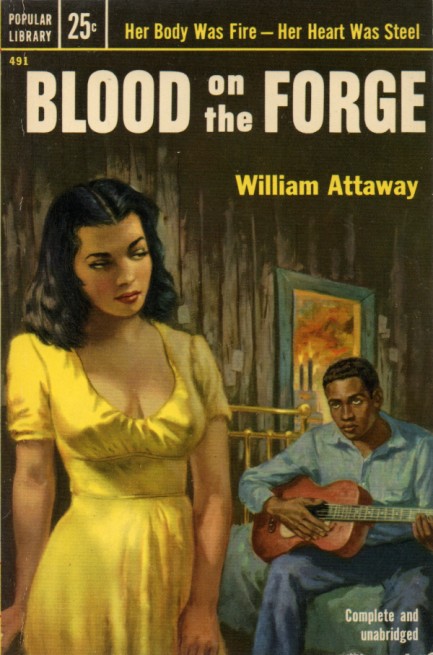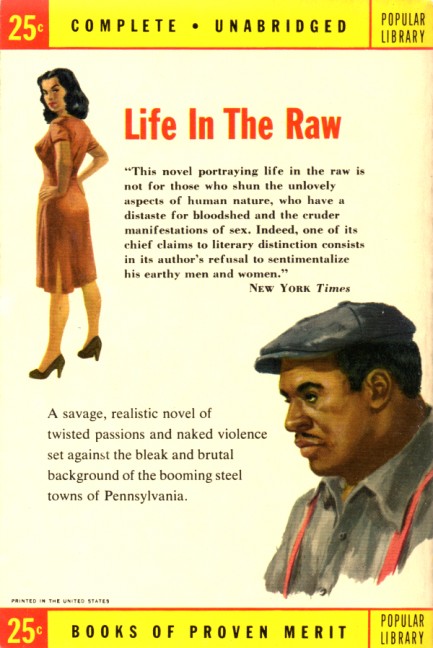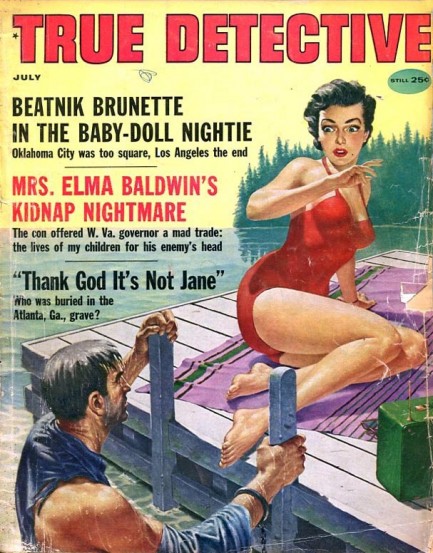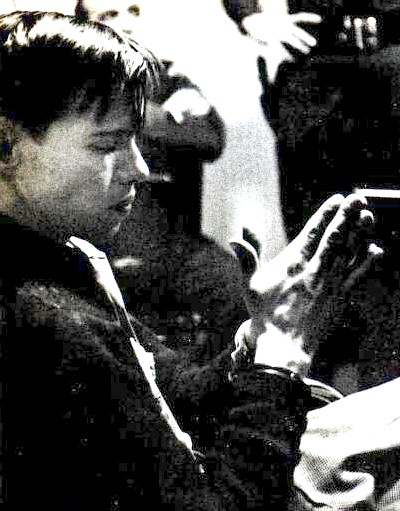 Geez, everyone's a damn critic. I mean, look around. I play the blues for a reason.  
Chicago based author William Attaway's Blood on the Forge is another of those highly serious literary novels that got the good-girl-art cover treatment. Numerous previously published authors were repackaged in this way during the 1950s. We're talking everyone from George Orwell to Aristarchus of Samos. This Popular Library edition is from the heyday of the makeover era—1953—but the book first appeared in 1941. It's about African American sharecroppers during the early twentieth century leaving their agrarian existence in Kentucky and heading to West Virginia, where they seek better lives and something closer to equality (the rear cover says Pennsylvania, but that happens much later in the story). This era is known historically as the Great Migration, when a lot of blacks got the hell out of the South and the increasingly vicious Jim Crow culture that thrived after slavery. The characters in Blood on the Forge find, like most real life migrants did, that the North is also unfair and difficult.
The cover art isn't as much of a stretch as it often is with these pulped up versions. The guitar player is Melody Moss, a major character, and the woman is Anna, who in the narrative is a Mexican girl of fourteen, but is depicted as well above the age of consent here. It's a pretty nice piece of art, though by an unknown (Ray Johnson? Owen Kampen?). As for the actual fiction, it was neglected for decades but it's now considered a literary classic and Attaway is recognized as an important figure of the Black Chicago Renaissance. Fitting, because Attaway was a real Renaissance man. He stopped writing novels after Blood on the Forge and moved into music and writing screenplays for radio, films, and TV. In 1957 he published the Calypso Song Book, a compendium of tunes he had collected. He also wrote for Harry Belafonte, including the classic "Banana Boat Song (Day O).” By the end of his career he had penned over 500 songs. You have to be impressed.
 They say vengeance is a dish best served cold, but we recommend passing entirely. 
Above is a very nice True Detective from July 1959 with a Brendan Lynch cover depicting a woman startled by the arrival of a criminal. It’s actually a perfect cover, because inside the issue you get an interesting story related by Elma Baldwin, who was kidnapped by a paroled convict named Richard Arlen Payne. Payne snatched Baldwin and three her kids at gunpoint as part of an ill-conceived plan to trade them for the release of his former cellmate Burton Junior Post, aka Junior Starcher, who was serving time at West Virginia State Penitentiary in Moundsville. Payne didn’t want Starcher out because they were buddies. Quite the opposite—he had vowed to kill the man, and threatened to torture and murder the Baldwins if his demands weren’t met. He wrote in a note to Governor Cecil Underwood, “My purpose is to kill and take the head of my worst enemy, who is now out of reach. I must kill him or go mad.”
You’re probably asking why Payne never did anything to Starcher while they were cellmates. Payne’s  answer was simple: “I could have killed him at any time, and I thought about it very seriously. At times I had a blade to his throat. But he was as good as done for anyway, because I knew once I got in the free world there were ways that I could get at him.” answer was simple: “I could have killed him at any time, and I thought about it very seriously. At times I had a blade to his throat. But he was as good as done for anyway, because I knew once I got in the free world there were ways that I could get at him.” Well, maybe not so much. In any case, the kidnapping was big news in 1959, probably owing to its sheer incomprehensibility. Today it’s mostly forgotten but remains a good case study of the benefits of being able to let go one’s anger. The entire event lasted only twenty hours, ending with a brief shootout in which nobody was injured, followed by Payne’s admittance to a mental asylum. Asked if Starcher had done anything specific during their time at Moundsville to engender such hatred, Payne said, “Well, nothing I can put my finger on. It was just a sort of natural hatred.”
|
 |

The headlines that mattered yesteryear.
1920—Negro National Baseball League Debuts
The first game of Negro National League baseball is played in Indianapolis, Indiana. The league, one of several that would be formed, was composed of The Chicago American Giants, The Detroit Stars, The Kansas City Monarchs, The Indianapolis ABCs, The St. Louis Giants, The Cuban Stars, The Dayton Marcos, and The Chicago Giants. 1955—Williams Wins Pulitzer
American playwright Tennessee Williams wins the Pulitzer Prize for Drama for his controversial play Cat on a Hot Tin Roof, which tells the story of a southern family in crisis, explicitly deals with alcoholism, and contains a veiled subtext concerning homosexuality in southern society. In 1958 the play becomes a motion picture starring Elizabeth Taylor and Paul Newman. 1945—Germany Announces Hitler's Death
German radio in Hamburg announces that Adolf Hitler was killed in Berlin, stating specifically that he had fallen at his command post in the Reich Chancery fighting to the last breath against Bolshevism and for Germany. But in truth Hitler had committed suicide along with his mistress Eva Braun, and both bodies were immediately thereafter burned. 1960—Powers Is Shot Down over U.S.S.R.
Francis Gary Powers, flying in a Lockheed U-2 spy plane, is shot down over the Soviet Union. The U.S. denies the plane's purpose and mission, but is later forced to admit its role as a covert surveillance aircraft when the Soviet government produces its remains and reveals Powers, who had survived the shoot down. The incident triggers a major diplomatic crisis between the U.S. and U.S.S.R. 1927—First Prints Are Left at Grauman's
Hollywood power couple Douglas Fairbanks and Mary Pickford, who co-founded the movie studio United Artists with Charlie Chaplin and D.W. Griffith, become the first celebrities to leave their impressions in concrete at Grauman's Chinese Theater in Hollywood, located along the stretch where the historic Hollywood Walk of Fame would later be established.
|

|
|

It's easy. We have an uploader that makes it a snap. Use it to submit your art, text, header, and subhead. Your post can be funny, serious, or anything in between, as long as it's vintage pulp. You'll get a byline and experience the fleeting pride of free authorship. We'll edit your post for typos, but the rest is up to you. Click here to give us your best shot.

|
|





 answer was simple: “I could have killed him at any time, and I thought about it very seriously. At times I had a blade to his throat. But he was as good as done for anyway, because I knew once I got in the free world there were ways that I could get at him.”
answer was simple: “I could have killed him at any time, and I thought about it very seriously. At times I had a blade to his throat. But he was as good as done for anyway, because I knew once I got in the free world there were ways that I could get at him.”



































































